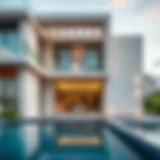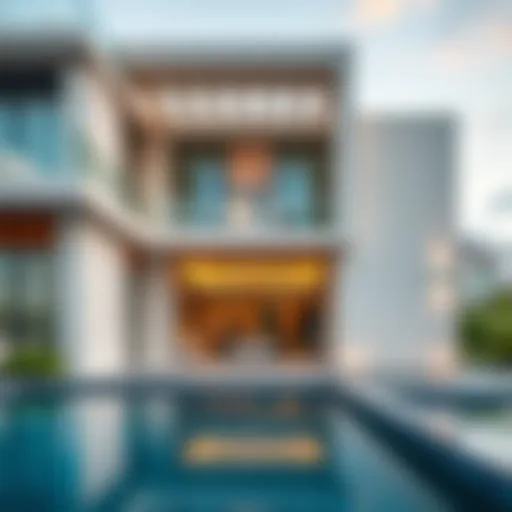Exploring Dubai's Metro Red Line Stations for Travelers
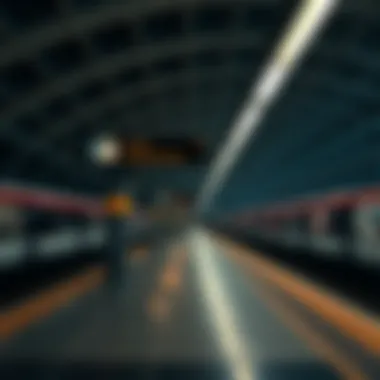

Intro
Dubai's Metro Red Line stands as one of the finest examples of urban planning and public transport systems in the Middle East. With 29 stations stretching across the city, it connects various key areas, making it an indispensable part of the daily commute for both locals and tourists alike. Understanding the Metro’s role goes beyond simply hopping on a train; it reflects the broader trends in urbanization and the economic dynamics of Dubai.
As Dubai continues to shine on the global stage, the Metro Red Line encapsulates its rapid growth and modernization. This guide not only covers the logistics of navigating the stations but also touches on how these hubs are influencing real estate development, urban architecture, and day-to-day conveniences. It's a journey through a network that reshapes connectivity while offering insights for homebuyers, investors, and urban planners looking to grasp the pulse of this vibrant city.
Intro to Dubai's Metro System
Dubai's Metro system stands as a testament to the rapid urbanization and innovative infrastructure initiatives within the city. It’s not just a method of getting from point A to point B; it represents a fundamental shift towards sustainable urban transport. With the growing population and influx of tourists, the Metro aims to alleviate traffic congestion while providing an efficient and reliable means of transportation.
A well-planned metro can make a world of difference in a bustling city like Dubai. It opens up myriad opportunities for business and leisure, allowing residents and visitors to navigate the city with ease. In particular, the Red Line serves as a spine to the metro network, connecting various regions and facilitating access to major attractions.
Benefits of the Metro System:
- Time-efficient travel: With trains running frequently, commuters avoid long waits, making journeys quicker.
- Cost-effectiveness: Public transport generally costs significantly less than car ownership, fuel, and parking in a city known for its luxurious lifestyle.
- Environmental sustainability: Reducing reliance on cars lowers carbon emissions, contributing positively to the urban air quality.
Considerations:
However, the operation of such a system does not come without its challenges. High maintenance costs, the need for continual upgrades, and addressing overcrowding during peak hours are persistent concerns. Nonetheless, the benefits greatly outweigh these issues, making the metro an essential component of urban planning in Dubai.
"Public transport is not just about moving people; it's about connecting communities and creating environments where people want to live and work."
The Metro system has altered how residents interact with their environment. It transforms daily commutes into seamless experiences, allowing people more time to enjoy what Dubai has to offer beyond travel. Understanding these dynamics provides invaluable insight, especially for homebuyers and investors considering proximity to metro stations in the evolving real estate landscape.
Key Characteristics of the Red Line
The Metro Red Line stands as a pivotal aspect of Dubai's public transport landscape. It's not just a mere transit system; it represents a careful orchestration of infrastructure, societal needs, and urban planning. By understanding its characteristics, we can appreciate how the Red Line acts as a thread weaving together disparate parts of the city, facilitating both mobility and development.
Route Details and Coverage
The route of the Red Line stretches over a remarkable 52 kilometers, linking many vital destinations across Dubai. Starting from Rashidiya in the east and culminating at UAE Exchange in the west, it encompasses 29 stations in total. Commuters can easily access key hubs such as Dubai International Airport, the vibrant Downtown area, and commercial locales like Deira.
What makes this route particularly advantageous is its well-planned interconnectivity. Not only does it serve passengers traveling from one point to another within the city, but it also merges seamlessly with other modes of transportation, such as buses and trams. This integration fosters a comprehensive network, reducing transit times significantly. For instance, a journey from Burj Khalifa to Dubai Airport on the Metro can be completed in less than 30 minutes—an impressive feat in this bustling metropolis.
In a city that can be quite sprawling, having a reliable metro line simplifies travel so you don’t have to stress about navigating heavy traffic. The accessibility of the Red Line is also enhanced by strategically placed stations that cover both residential and commercial neighborhoods, addressing the needs of a diverse commuter base. Here’s a quick glance at its features:
- Connectivity to Key Locations: Major attractions like Mall of the Emirates and Dubai Marina are directly accessible.
- Efficient Frequency: Trains run every 2 to 4 minutes during peak hours, reducing wait times.
- Safe and Reliable: Equipped with state-of-the-art security systems ensuring passenger safety at all times.
"The Red Line is not merely a transport route; it's a bridge that connects the heart of the city to its lifeblood—its people."
Station Design and Architecture
The character of the Red Line is not only defined by its route but also significantly by its stations. Each station has been thoughtfully designed to reflect modern aesthetic standards, catering not just to commuters but also contributing to the city’s visual landscape. You'll find an array of architectural styles, with elements inspired by Dubai's rich cultural heritage fused with contemporary designs.
For instance, the Burj Khalifa/Dubai Mall Station features spacious, well-lit areas made mostly of glass, giving a stunning view of the iconic Burj itself, juxtaposed with the hustle and bustle of daily commuters. This station doesn’t just embody efficiency; it enhances the overall commuter experience by offering various amenities. Travelers can find retail shops, food outlets, and other conveniences right within the station.
In contrast, stations like Union Station serve as transit hubs, diversified in their purpose. Beyond merely functioning as stops, they are designed with multi-level platforms, ensuring smooth occurence of foot traffic and minimizing congestion. Furthermore, environmentally conscious innovations are apparent, such as energy-efficient systems that illuminate the stations while preserving power.
Summing up, the characteristics of the Red Line provide vital insights not only into its operational efficacy but also into the urban planning strategy of Dubai. What you see in the structure and the usage represents much more than infrastructure; it’s a reflection of a city evolving with its aspirations and ambitions.
These elements draw in homebuyers, investors, and analysts alike, each eager to seize the opportunities presented by the urban mobility landscape that the Red Line cultivates.
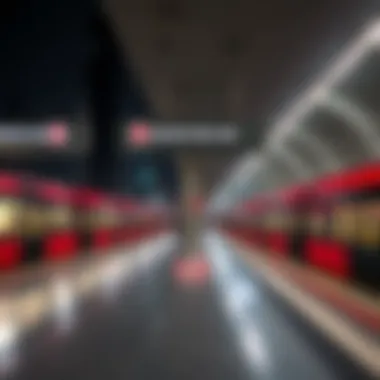

List of Major Red Line Stations
The Red Line of Dubai's Metro is a pivotal aspect of the city’s urban infrastructure. Each station serves as a gateway, bridging diverse neighborhoods and enhancing access to major landmarks. Understanding the importance of these major Red Line stations is crucial not only for daily commuters but also for homebuyers and investors looking to navigate the urban landscape effectively.
The stations along the Red Line not only support efficient transport but also influence property values and urban development. They offer connectivity to shopping centers, workplaces, and cultural attractions. This article section dives into three key stations: Union Station, Burj Khalifa/Dubai Mall Station, and Deira City Centre Station.
Union Station
Union Station serves as one of the central junctions of the Red Line. It’s a veritable hub that connects various metro lines, facilitating seamless transfers for commuters. This station is designed with both functionality and style in mind, featuring spacious platforms and modern amenities that cater to the flow of thousands of passengers daily. Its strategic location near several important landmarks enhances its significance—making it a natural choice for travelers.
Notably, the architecture incorporates elements of traditional Arabian design paired with contemporary functionality. Accessibility is another highlight; ramps and elevators ensure ease of movement for individuals with disabilities, making Union Station a model for inclusivity in urban transport.
Burj Khalifa/Dubai Mall Station
Burj Khalifa/Dubai Mall Station is perhaps the most high-profile station on the Red Line. Nestled at the foot of the world’s tallest building, it serves as the primary gateway to the iconic Dubai Mall, which is teeming with international brands, entertainment options, and dining experiences.
This station allows visitors to effortlessly transition from the metro to retail therapy. The design reflects the glitz of its surroundings, featuring large glass panels that provide a view of the Burj Khalifa, adding to the overall appeal. With dedicated drop-off zones and clear signage, navigating around the station is straightforward. The influx of visitors translates to increased foot traffic, benefiting local businesses and elevating property value in the vicinity.
Deira City Centre Station
Deira City Centre Station acts as a crucial access point for one of Dubai’s longstanding shopping hubs. Located in the bustling Deira district, this station is favored by both locals and tourists alike. The area around Deira is known for its rich history and vibrant culture, making it a desirable destination.
The station is characterized by its proximity to key attractions, including the famous Gold Souk and various dining establishments. Deira City Centre Station is well-equipped with facilities to ensure a pleasant experience, including waiting lounges and accessible routes for those with limited mobility.
In summary, the major stations along the Red Line not only define Dubai’s transportation landscape; they play a crucial role in shaping neighborhoods and influencing lifestyle options for residents and visitors. Each station represents a careful balance between accessibility, design, and urban integration, making them fundamental to the city’s ongoing development.
"Public transport is not just about moving people; it's about enhancing the places we live and work in."
In exploring these stations, it becomes evident how they contribute to a greater sense of community while providing necessary resources and connections for anyone navigating the urban sprawl.
Accessibility Features Across Stations
When navigating the complex Metro Red Line in Dubai, it’s crucial to consider accessibility features. These are indispensable for a variety of passengers, particularly those with disabilities or mobility challenges. The commitment to accessibility not only enhances the user experience but also ensures that public transport is inclusive to all, reflecting Dubai's vision of a thriving urban environment.
Facilities for Individuals with Disabilities
Dubai's Metro Red Line stations are equipped with multiple facilities designed to assist individuals with disabilities. Each station has ramps and tactile paving to help guide visually impaired passengers. Additionally, elevators are typically found at every station, providing easy access between different levels. The elevators are spacious and well-marked, allowing for wheelchair users and those with mobility aids to navigate without complications.
Key Features Include:
- Automatic Doors: These enable easier access, ensuring smooth entry and exit for those using wheelchairs or mobility scooters.
- Dedicated Waiting Areas: Each station has designated spaces for people with disabilities, making it easier for them to wait comfortably.
- Visual and Auditory Announcements: Information regarding train arrivals and departures is provided both visually on screens and audibly through announcements, catering to various needs.
These measures reflect the overall commitment to making the metro system not just a transport service, but a communal asset that caters to everyone's needs.
Transport Links to Other Services
Transport links are another critical aspect of accessibility on the Metro Red Line. Each station connects seamlessly to other modes of transport, enabling a smooth journey across the city. These links include buses, taxis, and even ride-sharing services, all designed to cater to a diverse population.
- Inter-Modal Connectivity: Most Red Line stations serve as hubs, connecting to various bus routes and taxi ranks. This convenience means passengers can transition effortlessly from one mode of transport to another.
- Information Assistance: Stations come equipped with information kiosks, often staffed by personnel who can assist individuals with disabilities. They can provide information in multiple languages and help in coordinating transport needs.
- Parking Facilities: Many stations feature dedicated parking spots for accessible vehicles. These are located close to station entrances, further enhancing convenience for drivers with disabilities.
The accessibility of the Metro Red Line stations in Dubai serves as a model for inclusive urban planning, ensuring that everyone, regardless of ability, has the opportunity to engage fully with the city's transport network.
Overall, the thoughtful design and planning of accessibility features along the Metro Red Line in Dubai play a significant role in fostering an environment of mobility for everyone. As urban areas continue to grow, prioritizing such features will be essential to achieving comprehensive and inclusive public transport.
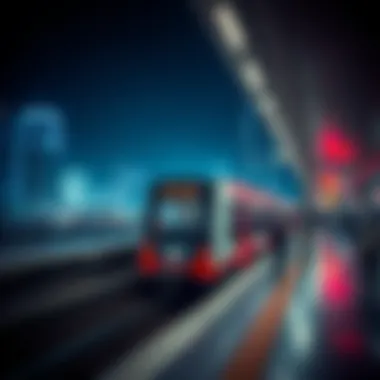

Impact on Real Estate Development
Navigating the complexities of Dubai's Metro Red Line directly intersects with real estate development in profound ways. The introduction and enhancement of public transport options, particularly the Metro, are a driving force behind property values, urban planning, and community dynamics. With stations positioned in strategic locales, the Red Line acts as a catalyst for both residential and commercial growth.
The conversation around property investment has shifted significantly due to this rail network. When homebuyers and investors contemplate new opportunities, they often weigh the proximity to transit systems as a critical factor. In Dubai, the Metro isn't just a means of transportation; it shapes neighborhood profiles and influences market trends.
Influence on Property Values
The presence of a Metro station can create a ripple effect on property values. Homes and businesses located within close reach of a Metro stop often see an uptick in demand. Investors are keenly aware that accessibility increases a property's intrinsic value, enticing both renters and buyers alike.
Consider the bustling area around the Burj Khalifa/Dubai Mall Station. Properties here generally command higher prices compared to neighborhoods far removed from transportation links. The allure of a short commute to work or quick access to leisure facilities draws individuals to these locales, thus impacting the real estate market.
Moreover, as these neighborhoods transform, the surrounding infrastructure—shops, schools, and parks—tends to improve as well. This enhancement in amenities only serves to bolster property values further.
"Transportation infrastructure is typically a major indicator of real estate market stability and growth."
Emerging Neighborhoods Along the Red Line
As the Red Line progresses, it also fosters the emergence of new neighborhoods that may not have been on the map just a decade ago. Areas like Dubai Marina and Al Quoz have burgeoned as key real estate hotspots, largely facilitated by their accessibility to Metro stations.
- Newly Developed Areas: Investors are finding opportunities in locales like Jumeirah Village Circle (JVC) and Dubai South. These neighborhoods, which were once considered underdeveloped, have gained favor due to their connection to the Metro.
- Community Integration: The Red Line not only connects disparate parts of the city but also cultivates a sense of community. As new housing projects rise, they often come with integrated transport links, enhancing overall livability.
- Shifts in Market Dynamics: As the Metro network expands, homebuyers are broadening their horizons. A once-quiet area may suddenly become prime real estate territory as accessibility improves.
By tracking these developments, keen investors can position themselves advantageously within the ever-evolving landscape of Dubai’s real estate market. Engaging with current trends helps not only to identify lucrative neighborhoods but also safeguards against emerging shifts that could affect property values.
Future Enhancements and Expansion Plans
The future of the Metro Red Line in Dubai holds promise. Enhancements and expansions are brewing, offering not just improved connectivity but also fostering the growth of commercial and residential areas. These developments are particularly crucial for homebuyers, investors, and urban planners, as they directly influence property values and living standards.
Upcoming Station Projects
One of the most exciting prospects on the horizon is the introduction of new station projects on the Red Line. Some notable stations planned to open soon include:
- Madinat Jumeirah Station: Aiming to connect tourists to the iconic resort, this station will enhance accessibility to luxurious hotels and sprawling beaches.
- Jumeirah Lakes Towers (JLT) Station: This is expected to cater to the bustling business community in JLT, promoting easier commutes for professionals.
- Dubai Marina Station Extension: The extension aims to better serve the vibrant Dubai Marina area, a popular hub for both residents and tourists.
These projects are not mere additions to the existing network; they represent a significant shift in urban planning philosophy in Dubai—strategically placing transit hubs in high-demand areas ensures efficient mobility and stimulates local economies.
Technological Advancements in Operations
Alongside station developments, technological advancements in operations are also pivotal. The integration of modern technology into the Metro's daily functions not only enhances passenger experiences but also boosts operational efficiency. Here are some of the key advancements:
- Smart Ticketing Systems: Soon to be introduced, these systems will allow for seamless travel through contactless payments, reducing waiting times at ticket counters.
- Real-time Monitoring Systems: These will provide passengers with up-to-the-minute updates on train schedules and any service disruptions, ensuring that commuters stay informed.
- Energy Efficiency Innovations: New energy-efficient trains are being deployed, which will reduce operational costs and the Metro's carbon footprint—a significant step toward sustainability.
Collectively, these enhancements indicate a future where the Metro Red Line is not just about transit but is a part of a larger, smarter urban ecosystem, fostering connectivity and convenience throughout the city.
As we look to the future, these enhancements will redefine the commuting experience, adding layers of efficiency and appeal to Dubai's Metro Red Line.
Environmental Considerations
The importance of environmental considerations in urban transport systems like Dubai's Metro Red Line cannot be overstated. As cities expand, the growing population and its associated transportation needs put immense pressure on the environment. Understanding how public transportation impacts both local ecosystems and urban air quality plays a crucial role in shaping sustainable development. This section dives deeper into the sustainability initiatives within the metro's operations and the overall influence of the Metro Red Line on urban air quality.
Sustainability Initiatives in Metro Operations
Dubai has positioned its metro system not only as a mode of transport but as a model for sustainability. Some key initiatives include:
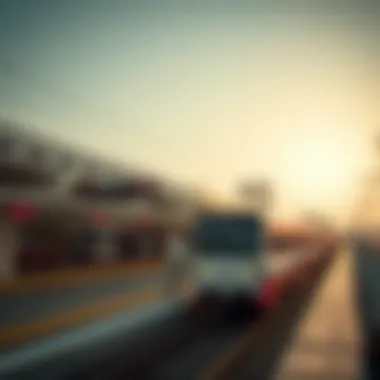

- Energy-efficient Trains: The metro trains are designed to minimize energy consumption. They utilize regenerative braking systems, which convert the energy generated during braking back into electricity, reducing overall energy use.
- Solar Energy Utilization: Various stations have integrated solar panels to harness renewable energy. This not only contributes to reducing the carbon footprint but also sets a precedent for future energy-efficient infrastructure projects.
- Water Conservation Systems: Innovative designs in station architecture include mechanisms to recycle and reuse water. Rainwater harvesting systems have also been established, which helps in managing water resources more effectively.
- Recycling Programs: The metro stations are equipped with recycling bins clearly marked for paper, plastic, and metal, encouraging commuters to participate in sustainable practices.
These initiatives foster a culture of sustainability among residents and visitors alike. They inspire the community to engage in environmentally friendly practices by demonstrating the metro’s commitment to green operations.
Impact on Urban Air Quality
The operational success of the Metro Red Line significantly affects air quality in Dubai. With the decrease in reliance on personal vehicles, there has been a noticeable reduction in vehicular emissions across the city. Improved air quality benefits public health, reducing respiratory issues commonly linked to pollution.
- Reduction of Greenhouse Gases: Statistical studies have demonstrated that regions with efficient public transit systems show lower levels of greenhouse gas emissions. By transporting such a large number of passengers daily, the metro system effectively lowers the total number of vehicles on the roads.
- Public Health Improvements: Improved air quality can lead to a decrease in health-related costs for both individuals and the government. Communities benefit from cleaner air, reducing the incidences of asthma and other air-related diseases, enhancing the quality of life.
"Cleaner public transport is not just an investment in infrastructure but a direct investment in the health and wellbeing of our populace".
- Commuter Preferences: Many commuters are increasingly aware of environmental issues; therefore, the availability of a reliable public transit system often influences their transport mode choice. An increased number of passengers opting for the metro means fewer emissions overall—a win-win for urban dwellers.
In summary, the impact of the Metro Red Line stretches far beyond convenience. Its role in promoting sustainability initiatives and enhancing urban air quality underscores the importance of this transport network in shaping a greener, healthier Dubai. For investors and stakeholders, aligning with such environmentally conscious developments could signal not only growth but a commitment to a sustainable future.
User Experiences and Feedback
Understanding user experiences and feedback is paramount when assessing the Metro Red Line stations in Dubai. With a focus on day-to-day commuters and occasional travelers alike, this section breaks down the various facets that make the experience of using the metro both convenient and secure. Valuable insights gleaned from these experiences can influence enhancements in future operational strategies and enhance the overall travel experience.
Commuter Comfort and Convenience
The design and functionality of each metro station play a vital role in commuter comfort. Dubai's Red Line is not just an efficient means of transport but also a space where user convenience is prioritized. Stations such as the Union Station and Burj Khalifa/Dubai Mall Station are equipped with modern facilities that cater to diverse needs.
- Seating and Waiting Areas: Comfortable seating arrangements are made available, enabling passengers to relax while they wait. Some stations boast lounges that almost feel like an extension of a cafe.
- Restroom Facilities: Clean and hygienic restrooms are a priority in encouraging use, and they are strategically placed to ensure easy access. This matters significantly for families and travelers with long routes.
- Information Displays: Real-time information boards help commuters stay updated about train schedules. Clear signage in multiple languages aids non-Arabic speakers, making the metro accessible for all.
Another key aspect is the availability of food and retail options within and around the stations. Small kiosks and shops cater to quick snacks and beverages, helping passengers grab a bite on the go. The seamless transition between modes of transport—whether buses or taxis—adds layers to the comfort and convenience of commuting. With these aspects in play, it becomes clear that users leave the metro experience feeling well taken care of.
Safety and Security Measures
Safety is always in the forefront when it comes to public transportation. The Red Line takes several measures to ensure the well-being of its passengers. Security personnel patrol the stations to provide assistance and maintain order, offering a visible reassurance to commuters.
- CCTV Surveillance: Each station is equipped with CCTV cameras, monitored closely to deter misconduct and enhance safety. This technology helps to quickly address any issues that may arise within the station.
- Emergency Preparedness: Regular drills and training refresh the protocols for security staff, ensuring they are ready for various situations. Monthly community engagement events often inform the public about safety practices.
- Accessibility Features: With heightened awareness for individuals with disabilities, the metro incorporates features such as ramps, elevators, and tactile signage. The provision of these facilities demonstrates a commitment to inclusivity, enhancing the general user experience.
Overall, data collected from commuter feedback reveals a strong emphasis on safety and convenience as vital elements of the travel experience. Passengers express a sense of security, which undoubtedly contributes to their willingness to utilize the metro regularly. By continually inviting and analyzing user feedback, authorities can iterate and adjust their services to better fit the needs of their diverse ridership.
Finale: The Future of Dubai's Urban Mobility
The future of urban mobility in Dubai is intricately linked with the ongoing development and expansion of the Metro Red Line. This deep-seated connection highlights several paramount aspects that demand attention, particularly for stakeholders such as homebuyers, investors, and urban planners.
Dubai aims to nurture a robust public transport system that eases congestion and enhances livability. The Metro Red Line stands as a testament to this vision. With its modern design, efficient operations, and extensive coverage, it showcases how mass transit can reshape urban landscapes. As the city continues to grow, the Red Line will undoubtedly play a crucial role in offering seamless connectivity across key districts.
Summary of Key Insights
In summarising the findings discussed throughout the article, several key insights arise concerning the Metro Red Line and its overall impact:
- Efficiency in Transport: The Metro Red Line is not just a transit option; it facilitates quick access to essential amenities across the city, making it a preferred mode of transport for daily commuters and tourists alike.
- Architectural Innovation: The aesthetic and practical aspects of station designs, such as the Burj Khalifa/Dubai Mall Station, stand out, serving both functional and artistic purposes.
- Influence on Real Estate: The rise in property values along the Red Line correlates directly with improved accessibility, encouraging development in areas previously deemed less favorable.
- Sustainability Efforts: The integration of green practices within Metro operations indicates a long-term commitment to environmental stewardship and urban sustainability.
These insights paint a picture of a forward-thinking city, where plans for improving urban mobility take center stage.
Implications for Stakeholders
The implications of the Metro Red Line's development extend beyond mere transportation and into the realms of real estate investment, urban planning, and social infrastructure. Stakeholders must consider the following:
- Investment Opportunities: Real estate investors should take note that properties adjacent to Metro stations are likely to see continued appreciation, making these areas ripe for investment. Various studies suggest that properties within proximity to public transport hubs generally fetch higher valuations.
- Planning Urban Infrastructure: City planners and developers face the opportunity (and responsibility) to align future developments with the Metro, ensuring a cohesive urban environment.
- Quality of Life Enhancements: Enhanced connectivity improves the quality of life for residents, giving them access to more resources and reducing commuting times. This can ultimately lead to a more satisfied populace.
"Transport systems define the future of urban living. Investment in them is not merely an economic decision but a commitment to societal advancement."
In summary, the Metro Red Line is central to Dubai's aspirations for a smarter, more connected future. Its impact is profound, affecting real estate dynamics, urban mobility, and overall quality of life in ways that warrant close examination by all who have a stake in Dubai's development.


